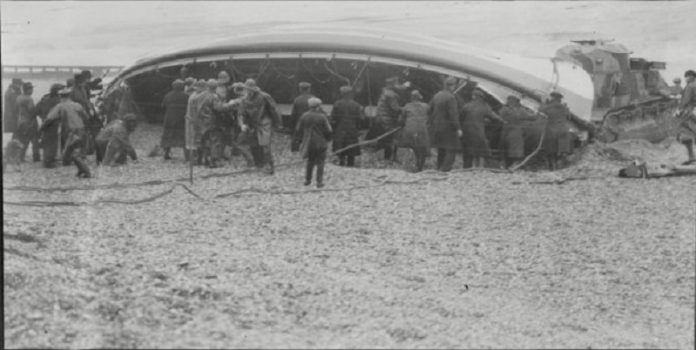One of the worst tragedies in the long and proud history of the Royal National Lifeboat Institution happened 90 years ago today, on November 15th, 1928.
The entire 17-man crew of the ‘Mary Stanford’ lifeboat was lost when it capsized in heavy weather off its home port of the village of Rye Harbour, on the East Sussex coast. Virtually the entire male fishing population of the close-knit village was wiped out in the disaster.
 Rye Harbour had taken delivery of its latest lifeboat in October 1916, named Mary Stanford after the benefactor whose legacy paid for the vessel. It was a 38ft ‘Liverpool class’ non-self-righting boat with 14 oars and a sail. Chosen by the crew who would operate her, this was thought to be the ideal craft for the type of conditions and rescues it would encounter in Rye Bay. The crew rejected a self-righting boat because it would have been too heavy to drag across the shingle beach to launch at Rye Harbour.
Rye Harbour had taken delivery of its latest lifeboat in October 1916, named Mary Stanford after the benefactor whose legacy paid for the vessel. It was a 38ft ‘Liverpool class’ non-self-righting boat with 14 oars and a sail. Chosen by the crew who would operate her, this was thought to be the ideal craft for the type of conditions and rescues it would encounter in Rye Bay. The crew rejected a self-righting boat because it would have been too heavy to drag across the shingle beach to launch at Rye Harbour.
The crew, made up of local fishermen, were pleased with their new boat, which launched 63 time between October 1916 and the disaster in November 1928. Most of those launches were training exercises, but 16 were real emergencies, known as ‘shouts’, and from these 10 lives were saved.
On the night of November 14th, 1928, a south-west gale swept up the English Channel, with winds in excess of 80mph. Lifeboat crews along the coast were on alert and just after 4am on the 15th a small Latvian steamer, ‘Alice of Riga’, was holed in her side and lost her rudder in a collision with a larger German vessel, ‘Smyrna’. A radio distress signal was sent and around 5am the ‘maroon rockets’ were fired at Rye Harbour Coast Guard Station, calling the lifeboat crew to action.
Despite the storm, the maroons woke most of the village and the lifeboat men rushed to the boathouse where they dressed in their oilskins and lifebelt and began dragging the Mary Stanford across the shingle. It was almost low water and it took three strength-sapping attempts to get the boat away. By the time they rowed away from the shore at 6-45am, the crew would have already been wet through and tired, but they pressed on as dawn broke over the swelling sea.
Just five minutes later the Rye Coastguard received a radio message that the stricken Alice of Riga’s crew had been successfully rescued by the Smyrna and were safe aboard. Frantic efforts ensued to recall the lifeboat, signalling with lights and firing flares, but in the driving rain and blinding seaspray, the crew did not see them as they pulled hard on their oars to make the mile-and-a-half journey.
Soon the lifeboat was lost to sight, but around 9am the mate of another ship off Dungeness reported seeing her and that all seemed well. The alarm went up around 10-30am, when a young lad collecting driftwood at Camber looked out to sea and spotted the Mary Stanford suddenly illuminated by a bright ray of sunshine breaking through the clouds. To his horror, he saw the boat suddenly capsize, and set off running to tell his parents.
At first he received a clout for ‘making up stories’, but to be on the safe side his father reported it to the local coastguard station. Soon rumours began to spread that the boat had ‘gone over’, confirmed around noon when she was sighted bottom up and floating towards shore. In Rye Harbour the villagers assembled on the shoreline, desperately hoping for good news, but fearing the worst, especially when the Mary Stanford washed up on the shingle. A tank was brought from the nearby army camp to haul her upright, but she was empty.
Over the next two hours, the bodies of her crew were brought home by the waves, 15 of them that day. It would be three months before a 16th body, that of 39-year-old Henry Cutting, washed ashore at Eastbourne, and the 17th crew member, 17-year-old John Head, was never found. In the aftermath of the disaster, villagers struggled to understand how the lifeboat came to be at the location where it was seen to capsize.
It had no need to be there, but most people thought either John Head or Henry Cutting – or both – had been washed out of the boat and the rest of the crew were searching for them when their vessel capsized. That, at least, would account for why the bodies of Head and Cutting did not wash ashore with the others.
Five days after the disaster, the 15 crew members were buried in a communal grave, where Henry Cutting’s body would later join them. Hundreds of mourners attended the funeral, where it was remarked that the crew of the Mary Stanford, including brothers, fathers and sons, had grown up together, worked together, laughed together, and would be buried together.
A memorial tablet of Manx stone was presented to Rye Harbour by the people of the Isle of Man and a memorial stained glass window was also placed in Winchelsea Church. Later, John Frederick Stanford, son of Mary Stanford, paid for another lifeboat, also named Mary Stanford in his mother’s memory. It had an illustrious career, saving 122 lives.
